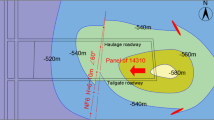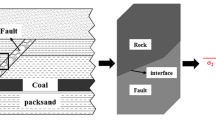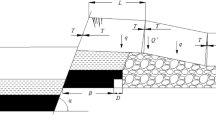Abstract
In coal seam mining, fault structures are easy to activate, which poses a serious threat to the safety of the mine during use. Therefore, the identification of physical information before fault activation and the prediction of fault activation have important guiding significance and reference value for the safety of coal mine production. For this reason, this paper first developed rock-like materials for simulating faults and surrounding rocks. On this basis, simulation experiments on the activation process of different types of analogical fault were carried out. The results showed that the failure process of rock-like samples with analogical concealed fault and analogical conduction fault could be divided into three stages, but the failure characteristics of each stage were different. The rock-like sample with analogical concealed fault began to crack in the form of tensile cracks at the structural tip, accompanied by the partial release of strain energy, and the whole sample was stable. In the crack initiation stage of the analogical surrounding rock, the analogical surrounding rock became the main bearing zone, the weak area of the analogical surrounding rock produced a tensile crack, releasing a small amount of strain energy, and the sample remained in a stable failure state. The rock-like samples with analogical conduction fault began to crack at the interface between the analogical fault and the analogical surrounding rock in the form of a shear crack, which released part of the strain energy. The sample had a sliding trend, but it was stable as a whole. At the stage of crack generation and propagation, new shear cracks appeared at the interface, which were affected by the released and secondary accumulated strain energy; some of the strain energy was released, and the sample was basically stable. In the early stage of sliding instability, which is the key period to prevent fault activation, the stress change was relatively stable, and less strain energy was released. In the later stage, the new shear cracks were connected with the existing shear crack, and the sample underwent sliding instability failure, which released a large amount of strain energy.














Similar content being viewed by others
References
Amini A, Eberhant E (2019) Influence of tectonic stress regime on the magnitude distribution of induced seismicity events related to hydraulic fracturing. J Pet Sci Eng 182:1–12
Asadizadeh M, Hossaini MF, Moosavi M, Masoumi H, Ranjith PG (2019) Mechanical characterisation of jointed rock-like material with non-persistent rough joints subjected to uniaxial compression. Eng Geol 260:105224
Chen SJ, Du ZW, Zhang Z et al (2020) Effects of chloride on the early mechanical properties and microstructure of gangue-cemented paste backfill. Constr Build Mater 235:117504
Hou D, Zhang W, Sun M, Wang P, Wang M, Zhang J, Li Z (2020) Modified Lucas Washburn function of capillary transport in the calcium silicate hydrate gel pore: a coarse-grained molecular dynamics study. Cem Concr Res 136:106166
Huang DM, Chang XK, Lin XF et al (2014) The fractal dimension of rock crack under uniaxial compression. J Shandong Univ Sci Technol (Nat Sci) 33(2):58–62
Huang Z, Zeng W, Zhao K (2019) Experimental investigation of the variations in hydraulic properties of a fault zone in Western Shandong, China. J Hydrol 574:822–835
Jiang LS, Wang P, Zheng PQ et al (2019) Influence of different advancing directions on mining effect caused by a fault. Adv Civil Eng 2019:1–10
Khademian Z, Ozbay U (2019) Modeling violent rock failures in tunneling and shaft boring based on energy balance calculations. Tunn Undergr Space Technol 90:62–75
Kursunoglu, Nilufer O, Mustafa (2019) Application of structural equation modeling to evaluate coal and gas outbursts. Tunn Undergr Space Technol 88:63–72
Li HD, Lan H, Du TT et al (2013) Micro-seismic characteristic and danger relief method in rock-burst danger period of mining face under hard and thick roof of Kuangou Mine[J]. J China Coal Soc 38(S1):6–11
Li W, Xiang Ren TW, Busch A et al (2018) Architecture, stress state and permeability of a fault zone in Jiulishan coal mine, China: implication for coal and gas outbursts. Int J Coal Geol 198:1–13
Manzi MSD, Durrheim RJ, Hein KAA et al (2012) 3D edge detection seismic attributes used to map potential conduits for water and methane in deep gold mines in the Witwatersrand basin, South Africa. Geophysics 77(5):133–147
Naji AM, Emad MZ, Rehman H, Yoo H (2019) Geological and geomechanical heterogeneity in deep hydropower tunnels: a rockburst failure case study. Tunn Undergr Space Technol 84:507–521
Qian ZW, Zhen H, Song JG (2018) A case study of water inrush incident through fault zone in China and the corresponding treatment measures. Arab J Geosci 11(14):381–387
Shen BT, Barton N (2018) Rock fracturing mechanisms around underground openings. Geomech Eng 16(1):35–47
Wang XL (2019) Numerical simulation research of coal and gas outbursts near tectonic region in Ping ding shan mining area[J]. Arab J Geosci 12(18):583
Wang HW, Shi RM, Lu CS et al (2019a) Investigation of sudden faults instability induced by coal mining. Saf Sci 115:256–264
Wang P, Jiang LS, Zheng PQ, Qin GP, Zhang C (2019b) Inducing mode analysis of rockburst in fault-affected zone with a hard-thick stratum occurrence. Environ Earth Sci 78(15):467
Yin HY, Zhao H, Xie DL et al (2019) Mechanism of mine water inrush from overlying porous aquifer in Quaternary: a case study in Xinhe Coal Mine of Shandong Province, China. Arab J Geosci 12(5):163
Zhai C, Xiang XW, Xu JZ (2016a) The characteristics and main influencing factors affecting coal and gas outbursts in Chinese Pingdingshan mining region. Nat Hazards 82(1):507–530
Zhai C, Xiang XW, Xu JZ et al (2016b) The characteristics and main influencing factors affecting coal and gas outbursts in Chinese Pingdingshan mining region. Nat Hazards 82(1):507–530
Zhang SC (2018) Experimental studies on catastrophe information identification of structural activation and water inrush mechanism in mining floor. Shandong University of Science and Technology, China
Zhang SC, Guo WJ, Li YY et al (2017) Experimental simulation of fault water inrush channel evolution in a coal mine floor. Mine Water Environ 36(3):443–451
Zhao C, Niu JL, Zhang QZ et al (2019) Numerical simulations on cracking behavior of rock-like specimens with single flaws under conditions of uniaxial and biaxial compressions. J Mater Civ Eng 31(12):04019305
Zhou QL, Herrera J, Hidalgo A (2018) The numerical analysis of fault-induced mine water inrush using the extended finite element method and fracture mechanics. Mine Water Environ 37(4):1–11
Zhu WC, Wei WH (2011) Numerical simulation on mining-induced water inrushes related to geologic structures using a damage-based hydromechanical model. Environ Earth Sci 62(1):43–54
Zuo YJ, Wang H, Yu ML et al (2018) Study on catastrophe theory of activation-induced prominence of faults under dynamic disturbance. Adv Civil Eng 2018:1–8
Data availability statement
The data in this article were obtained through laboratory experiments, and all authors were able to ensure the authenticity of the data. But the data used to support the findings of this study are currently under embargo while the research findings are commercialized. Requests for data, 6 months after publication of this article, will be considered by the corresponding author. Thank you for your understanding.
Funding
This research were financially supported by the National Natural Science Foundation of China (51974173, 5200041022), Key research and development plan of Shandong Province (2019GSF111024) and Shandong Province’s Taishan Scholar Talent Team Support Plan for Advantaged & Unique Discipline Areas.
Author information
Authors and Affiliations
Corresponding author
Ethics declarations
Conflict of interest
The authors declare that they have no conflicts of interest.
Additional information
Responsible Editor: Abbas Taheri
Rights and permissions
About this article
Cite this article
Chen, B., Zhang, S., Li, Y. et al. Physical simulation study of crack propagation and instability information discrimination of rock-like materials with faults. Arab J Geosci 13, 966 (2020). https://doi.org/10.1007/s12517-020-05966-8
Received:
Accepted:
Published:
DOI: https://doi.org/10.1007/s12517-020-05966-8




